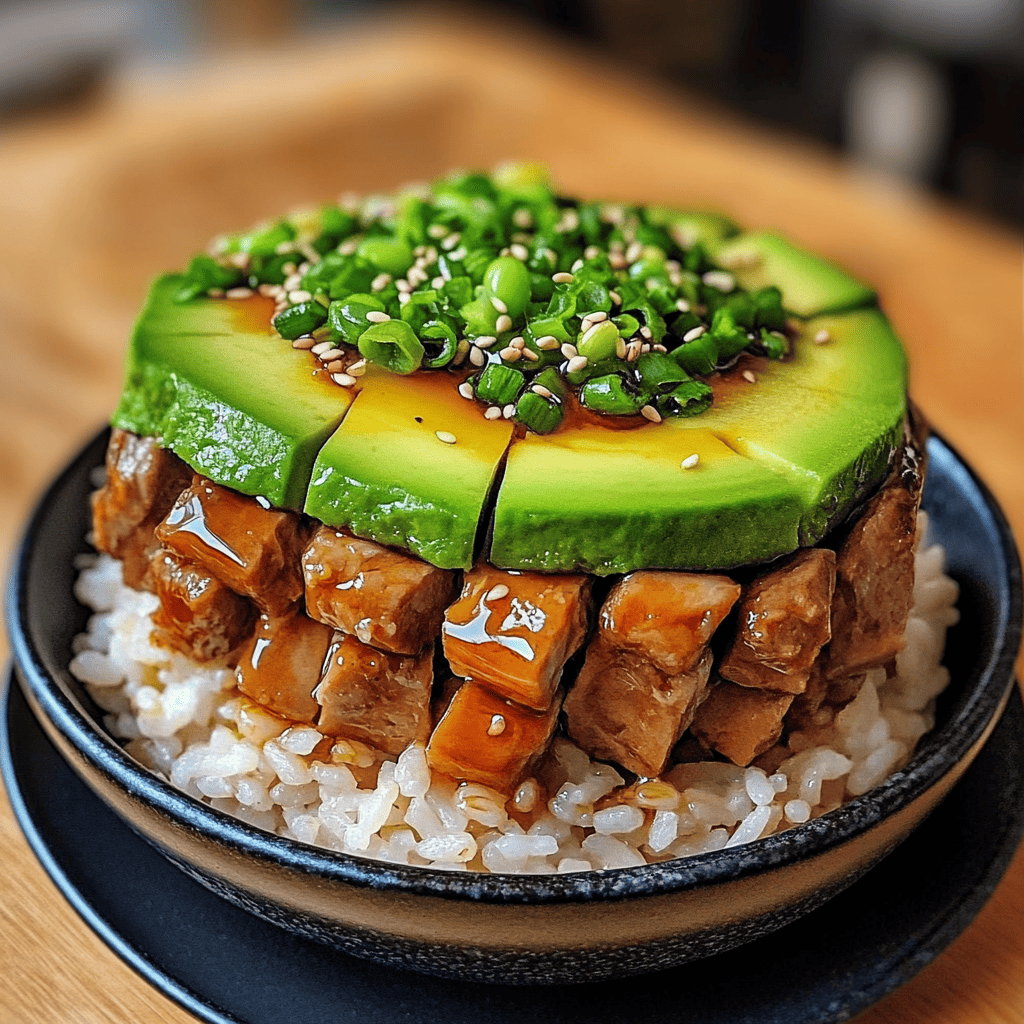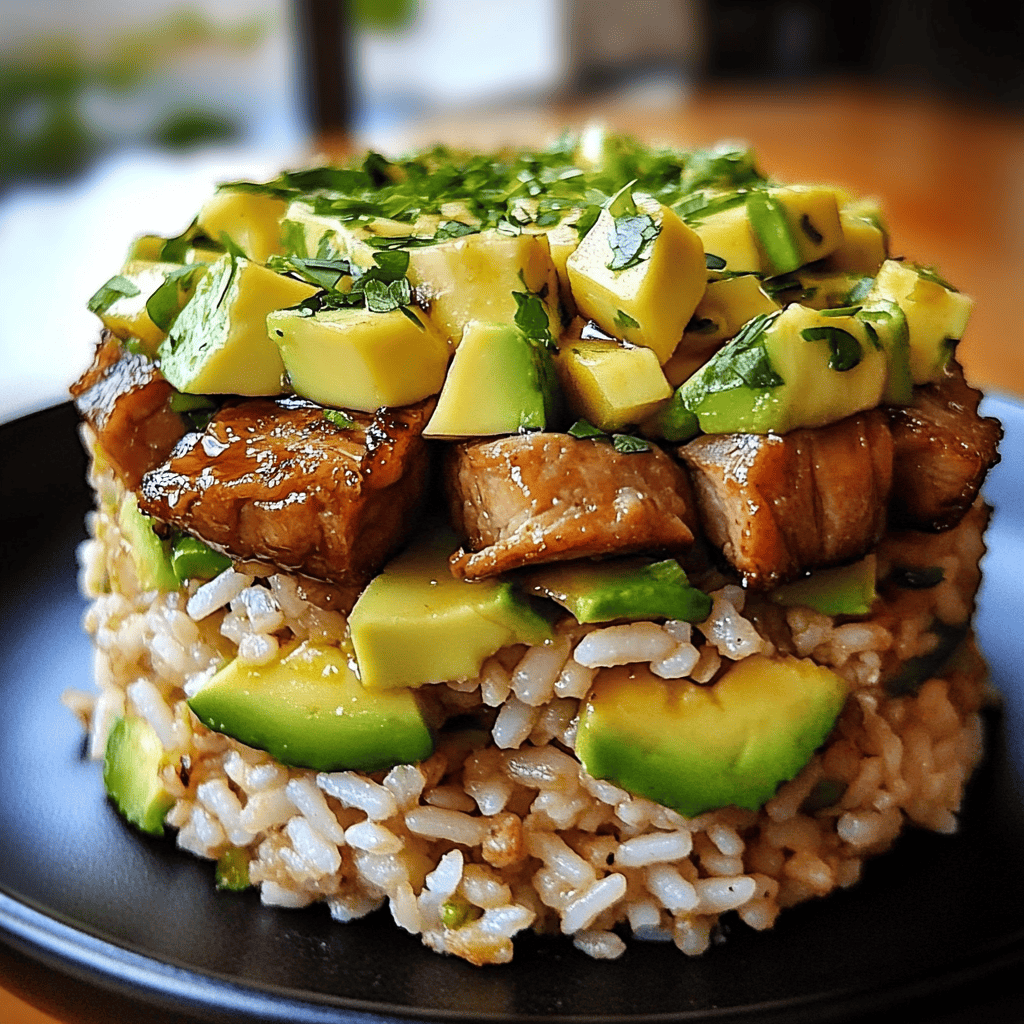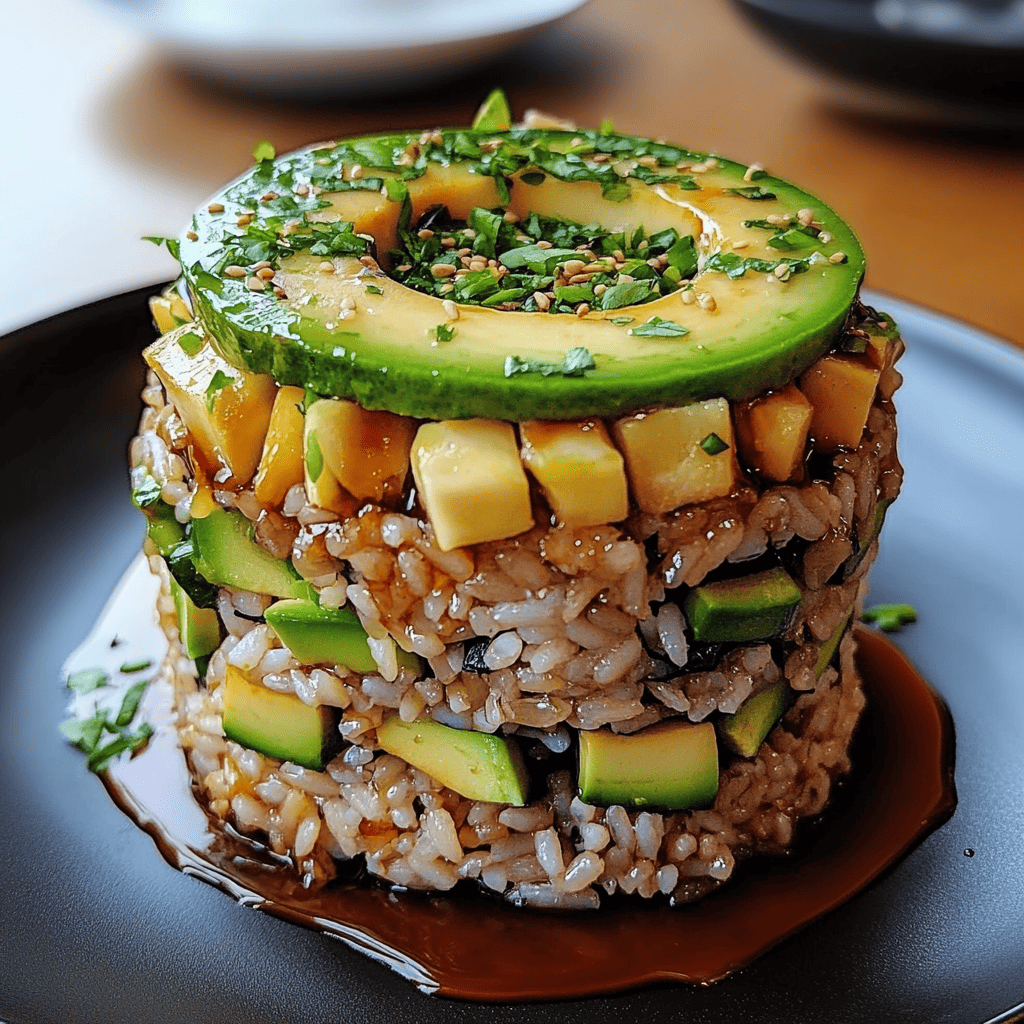Beef Teriyaki Rice with Avocado: A Journey of Oriental Flavors
Introduction
On the global culinary scene, the fusion of flavors and cultures has given rise to truly exceptional dishes. “Beef and Avocado Teriyaki Rice” is a clear example of this delicious synergy, combining the rich Asian tradition of teriyaki and rice with the creamy, healthy touch of avocado, so present in the cuisines of the Americas and beyond. This dish is not only an explosion of flavor but also a complete and nutritious option, ideal for a balanced and comforting meal. Tender and flavorful beef, bathed in a homemade teriyaki sauce that balances sweet and savory, sits on a bed of flavorful rice, crowned by silky, fresh avocado slices. It’s a culinary offering that promises to delight the most discerning palates and adapts perfectly to the dynamics of modern life.
Detailed History
To understand the richness of this dish, it is essential to break down the history of its main components.
Rice: Rice is the most widely consumed cereal grain in the world and a fundamental pillar in the diet of billions of people, especially in Asia. Its domestication dates back thousands of years, with evidence suggesting its cultivation in China around 8000 BC and in the Indus Valley around 5000 BC. Since its origins in Asia, rice has spread across the globe, adapting to different climates and culinary cultures. In Japan, rice is not only a staple food, but also has deep cultural and spiritual significance, being the center of many meals and ceremonies.
Teriyaki Sauce: The word “teriyaki” is of Japanese origin and is composed of “teri” (輝き), which refers to the shine that the sugar in the sauce gives to the meat when cooked, and “yaki” (焼き), which means to roast or grill. Teriyaki sauce is traditionally made with soy sauce, mirin (sweet rice wine), sake (rice wine), and sugar or honey. Its original use was to marinate and glaze fish and meat, giving them a deep umami flavor, sweetness, and a characteristic caramelized shine. Although its origins are Japanese, teriyaki’s popularity skyrocketed in the West, especially in Hawaii and the United States, where Japanese immigrants adapted the recipe to local ingredients and made it sweeter and thicker, often using pineapple or ginger. The version we see today in many supermarkets is an evolution of that adaptation.
Beef: Beef has been a vital food source for humanity since prehistoric times. Its consumption has spread throughout the world, with different cuts and preparations adapted to local cuisines. In many Asian cultures, beef is used in quick stir-fries, soups, and stews, often cut into thin strips to ensure rapid cooking and a tender texture. Sirloin, a premium cut, is especially valued for its tenderness and mild flavor, making it ideal for dishes that require quick cooking.
Avocado: The avocado has a long history in Mesoamerica, where it was cultivated by civilizations like the Aztecs and Mayans since 5000 BC. It was considered a sacred food and prized for its nutritional value and creamy flavor. Although its origins are American, the avocado has gained immense global popularity in recent decades, thanks to its culinary versatility and health benefits. Its incorporation into Asian-inspired dishes, like this teriyaki rice, exemplifies modern culinary fusion, where ingredients from different origins combine to create exciting new flavor profiles.
More Historical Detail
The evolution of teriyaki sauce is particularly fascinating. In Japan, teriyaki is more of a cooking technique than a prepackaged sauce. Japanese chefs prepare their own “tare” sauce (the base of teriyaki) fresh for each preparation, adjusting the balance of the four main ingredients. When Japanese immigrants arrived in Hawaii in the late 19th century to work on sugarcane and pineapple plantations, they began adapting their cuisine. They discovered that pineapple juice was an excellent meat tenderizer and sweetener, which led to the creation of a sweeter, thicker version of teriyaki sauce. This Hawaiian version significantly influenced the popularity of bottled teriyaki sauce in the United States, which often contains additional ingredients like ginger, garlic, and starch for thickening.
The combination of rice, beef, and avocado in a single dish reflects current trends in global cuisine. The poke bowl is a popular format that has allowed for creativity in combining proteins, grains, vegetables, and healthy fats. This dish, while not a traditional poke bowl, shares the philosophy of a complete and well-balanced meal in a single container. It’s an example of how culinary traditions can evolve and merge to meet the tastes and needs of a global audience.

Ingredients
Get your utensils and these fantastic ingredients ready for a feast of flavors!
For the rice:
- 2 cups of rice (preferably medium or long grain)
- 3 cups chicken broth (or vegetable broth for a lighter option)
- 1/4 cup soy sauce
- 1 tablespoon sesame oil
- 1/4 teaspoon garlic powder
For the meat:
- 1 pound (about 450 g) boneless sirloin steak, thinly sliced
- 1/4 cup teriyaki sauce (homemade or good quality)
- 1/4 cup honey
- 1/2 teaspoon grated ginger (fresh is best)
For the avocado:
- 1 ripe avocado, sliced or diced
Optional (to decorate and add more flavor):
- Toasted sesame seeds
- Chopped spring onion (green part)
Detailed Preparation
Follow these steps precisely to achieve a perfect dish:
Step 1: Preparing the Flavored Rice
- Rinse the rice under cold water several times until the water runs clear. This helps remove excess starch and prevents the rice from sticking together. Drain well.
- In a medium saucepan with a lid, combine the washed rice, chicken broth, soy sauce, sesame oil, and garlic powder.
- Bring the mixture to a boil over high heat. Once boiling, reduce heat to low, cover the pot tightly with the lid, and cook for 15-20 minutes, or until all the liquid is absorbed and the rice is tender. Avoid lifting the lid while cooking.
- Once cooked, remove the pot from the heat and let the rice rest, covered, for an additional 5-10 minutes. This allows the grains to steam completely and become more fluffy. After resting, fluff the rice with a fork.
Step 2: Preparing the Teriyaki Meat
- While the rice is cooking, prepare the meat. In a medium bowl, combine the teriyaki sauce, honey, and grated ginger. Mix well until the honey is completely dissolved in the sauce.
- Add the thinly sliced sirloin steak to the bowl with the marinade. Make sure the meat is well coated in the sauce. You can let it marinate for at least 15 minutes at room temperature, or up to 30 minutes in the refrigerator if you have extra time to intensify the flavor.
- In a large skillet or wok over medium-high heat, add a little oil (vegetable or sesame oil if desired). Once hot, add the marinated beef slices in a single layer. Don’t overcrowd the skillet; cook the beef in batches if necessary to ensure a good sear and prevent overcooking.
- Cook the meat for 2-3 minutes on each side, or until browned and cooked to your liking. Sirloin steak cooks very quickly.
- Once all the meat is cooked, if there’s any marinade left in the bowl, you can pour it into the pan with the rest of the sauce that’s formed, and let it simmer for a minute to thicken slightly and serve as an additional glaze.
Step 3: Preparing the Avocado
- While the meat is cooking, prepare the avocado. Carefully cut the ripe avocado in half, removing the pit and skin.
- Cut the avocado into even slices or cubes, depending on your preference. To prevent browning, you can lightly sprinkle it with lemon or lime juice.
Step 4: Assembly and Serving
- To serve, place a generous portion of the flavored rice in the bottom of a bowl.
- Arrange the beef teriyaki slices over the rice.
- Place the avocado slices or cubes next to the meat.
- If desired, garnish with toasted sesame seeds and chopped scallions for a touch of color and fresh flavor.
- Serve immediately and enjoy this complete and flavorful dish.
Estimated Preparation Time
- Active preparation time: 20-25 minutes
- Rice cooking time: 15-20 minutes (plus 5-10 minutes of rest)
- Meat cooking time: 6-10 minutes (in batches)
- Meat marinating time: 15-30 minutes (optional)
- Estimated total time: 45-60 minutes
Additional Tips
- Quality of Ingredients: The quality of the ingredients makes a big difference. Use a good cut of meat and a quality soy sauce. If you can make your own homemade teriyaki sauce, the flavor will be superior.
- Rice: For even more aromatic rice, you can lightly toast dry rice in the pot before adding the liquid. Jasmine or basmati rice also works, although medium-grain rice is traditional for this type of dish.
- Slicing Meat: Slicing meat very thinly is key to ensuring it cooks quickly and stays tender. You can semi-freeze the meat for 20-30 minutes before slicing it to make it easier to get even, thin slices.
- Fresh Ginger: While powdered ginger is an option, grated fresh ginger adds a much more vibrant and spicy aroma and flavor to the marinade.
- Honey: If you prefer a less intense sweetness, you can slightly reduce the amount of honey or replace some with brown sugar.
- Homemade Teriyaki Sauce: If you want to elevate the dish, consider making your own teriyaki sauce. A basic recipe includes equal parts soy sauce, mirin, and sake, with a little sugar and grated ginger/garlic.
- Avocado: Choose a ripe, but firm avocado. To prevent browning, drizzle it with lemon or lime juice immediately after cutting it.
- Variations: You can add other sautéed vegetables to the dish, such as broccoli, carrots, mushrooms, or peppers, to make it even more complete and nutritious.

Questions and Answers
Can I use another type of meat? Yes, you can substitute the sirloin with chicken breast, chicken thigh, or even firm tofu for a vegetarian option. Adjust cooking times according to the type of protein.
What should I do if I don’t have chicken broth? You can use water instead, although chicken broth adds more flavor to the rice. If you use water, consider adding a dash more soy sauce or a bouillon cube to compensate.
How can I make teriyaki sauce thicker? If you want a thicker teriyaki sauce to glaze meat, you can mix one teaspoon of cornstarch with one tablespoon of cold water and add this mixture to the sauce in the pan while it’s simmering over low heat. Cook until thickened.
Can I prepare the meat in advance? You can marinate the meat in advance (up to 24 hours in the refrigerator), which will even intensify its flavor. Cook it just before serving to ensure tenderness. The rice can also be prepared in advance and heated.
How to prevent avocado from browning? In addition to lemon/lime juice, storing cut avocados in an airtight container with a slice of onion (not in direct contact with the avocado) can help delay browning.
Texture and Flavor
This dish is a delight for the senses, offering a complex interaction of textures and flavors:
- Texture: The rice is fluffy and slightly sticky , making it perfect for absorbing juices. The beef is incredibly tender and juicy , sliced thin enough to melt in your mouth. The avocado adds a silky, creamy texture that contrasts beautifully with the rest of the ingredients. The sesame seeds, if used, add a subtle crunch .
- Flavor: The flavor profile is a harmony of sweet, savory, umami, and a touch of freshness . The teriyaki sauce is at the heart of the meat’s flavor, with its sweetness from the honey and the saltiness from the soy sauce, complemented by the slightly spicy and aromatic touch of ginger. The rice absorbs the richness of the chicken broth and soy sauce, creating a savory and slightly salty base. The avocado offers a smooth, buttery flavor , acting as a refreshing and balancing counterpoint to the intensity of the teriyaki. Garlic powder in the rice and spring onion in the garnish add aromatic notes that round out the flavor profile.
Consumer Context
“Beef Teriyaki Rice with Avocado” is an incredibly versatile dish, suitable for a variety of contexts:
- Daily Main Meal: This is a great option for a weeknight dinner, as it’s relatively quick to prepare and offers a complete meal in one bowl.
- Meal Prep: The ingredients (rice and meat) can be prepared in advance, making it ideal for weekly meal prep. Simply add fresh avocado just before eating.
- Comfort Food: Its combination of warm rice and savory meat makes it a comforting dish, perfect for a cold night or when you’re looking for something nutritious and satisfying.
- Informal Occasions: Ideal for informal gatherings with friends or family, as it is an easy-to-serve dish that is usually popular with most people.
- Pairing: Pairs well with Japanese beer (such as Asahi or Sapporo), light sake, or a crisp, fruity white wine like Sauvignon Blanc or Pinot Grigio. For non-alcoholic drinks, green tea or ginger and lemon-infused water are excellent options.
Visual Aspect
The “Beef Teriyaki and Avocado Rice” is visually appealing, with a palette of colors and textures that invite you to devour it:
- White Rice Base: The rice, fluffy and white or lightly browned by the soy sauce, forms a neutral yet inviting base in the bowl.
- Glossy Glazed Beef: Teriyaki beef strips have a glossy reddish-brown color and a caramelized appearance due to the honey glaze and teriyaki sauce. Their surface is slightly sticky and mouthwatering.
- Vibrant Avocado: Slices or cubes of avocado add a vibrant contrast with their pale to deep green color, which stands out against rice and meat. Its creamy texture is immediately apparent.
- Fresh Pops of Color: When used, toasted sesame seeds add small dots of black and white color, and chopped scallions introduce bright green accents, enhancing the freshness and overall aesthetic of the dish.
- Balanced Layout: The dish is presented so that the three main components are clearly visible and well distributed, creating a balanced and harmonious composition.
Overall, the dish radiates a sense of freshness, nutrition and flavor, making it irresistible.
Curiosities
- Umami: Teriyaki sauce is a prime example of an umami flavor, often described as “savory” or “meaty,” and is considered the fifth basic taste alongside sweet, salty, sour, and bitter.
- Benefits of Ginger: Ginger, a key ingredient in the marinade, not only adds flavor but is also known for its anti-inflammatory and digestive properties.
- Avocado is a Fruit: Although often used as a vegetable in savory cooking, botanically, the avocado is a fruit, a single-seeded berry.
- Sesame Oil: Sesame oil is used in small amounts in Asian cooking for its strong aroma and nutty flavor, rather than for its high-heat cooking properties.
- Sirloin Cut: The sirloin is one of the most tender cuts of meat because it is a muscle that is barely used in the animal’s movement.
- Rice and Health: Brown rice (not used in this recipe but related) is an excellent source of fiber, and both types of rice (white and brown) are a gluten-free source of energy.
Nutritional Value (estimated per serving)
It’s important to remember that these values are estimates and can vary significantly depending on the exact serving size, cut of meat, brand of teriyaki sauce, and amount of oil used. This recipe makes approximately 4 servings.
Estimated serving (1/4 of the recipe):
- Calories: 550-650 kcal
- Total Fat: 20-30 g
- Saturated Fat: 5-8 g
- Cholesterol: 80-100 mg
- Sodium: 800-1000 mg (can vary greatly depending on soy and teriyaki sauce)
- Total Carbohydrates: 60-70 g
- Sugars: 15-20 g (from honey and teriyaki sauce)
- Fiber: 4-6 g
- Protein: 35-45 g
Considerations:
- Sodium: Soy sauce and teriyaki sauce are high in sodium. If you’re concerned about sodium intake, opt for low-sodium versions of these ingredients.
- Healthy Fats: Avocado is an excellent source of monounsaturated fats, which are beneficial for cardiovascular health.
- Protein: Beef is a complete source of protein and contains B vitamins and iron.
- Carbohydrates: Rice provides complex carbohydrates for sustained energy.
This dish is a well-balanced meal that provides a good combination of essential macronutrients.
Additional Benefits and Interesting Facts
- Cardiovascular Health: The healthy fats in avocado and the omega-3s found in certain types of meat (if grass-fed) or in the addition of sesame seeds contribute to heart health.
- Sustained Energy: The combination of complex carbohydrates from rice and proteins from meat provides sustained energy, helping you stay full longer.
- Rich in Vitamins and Minerals: This dish provides a variety of vitamins and minerals, including B vitamins (from the meat and rice), vitamin K and potassium (from the avocado), and iron (from the meat).
- Dietary Versatility: Incorporating dishes like this into your diet encourages diversity and exposure to different flavors and culinary cultures, which can make a healthy diet more interesting and sustainable.
- Gluten: If gluten-free soy sauce and gluten-free teriyaki sauce are used, this dish may be suitable for people with gluten sensitivity or celiac disease.
Other Information
- Storage: The components of this dish store well separately in the refrigerator for 3-4 days in airtight containers. The avocado should be sliced just before serving.
- Reheating: Rice and meat can be easily reheated in the microwave or in a pan with a little water or broth to prevent them from drying out.
- Presentation: For a more elegant touch, you can use molds to form the rice into a round or square base before adding the meat and avocado.
- Sustainability: Consider choosing sustainably sourced beef and fair trade avocados to support ethical and environmental practices.

Conclusion
“Beef Teriyaki Rice with Avocado” is much more than a simple recipe; it’s a celebration of global cuisine, where the depth of Asian flavors meets the freshness and creaminess of an ingredient as versatile as avocado. It’s a dish that satisfies not only the appetite but also the desire for a rich and balanced culinary experience. Easy to prepare and visually appealing, it becomes an ideal choice for any day of the week, promising a comforting, nutritious, and flavorful meal. Dare to prepare this delight and discover why culinary fusion is one of the greatest joys of gastronomy.

